Audit Report: DIPL Audit Procedures, Risk and Fraud Analysis
VerifiedAdded on 2020/03/01
|9
|2047
|65
Report
AI Summary
This audit report provides a comprehensive analysis of DIPL, focusing on various aspects of financial auditing. The report begins by discussing the importance of audit in the context of increasing regulations and compliance requirements. It explores different audit procedures, including substantive and analytical procedures, and their significance in assessing financial statements. The report then delves into the specific case of DIPL, a company undergoing its first audit by a new firm, highlighting the importance of considering system and policy changes. It analyzes key financial ratios like liquidity, profitability, debt management, and asset management ratios to assess the company's financial health. The report identifies potential inherent risks, control risks, and detection risks within DIPL, particularly in areas like new policy adoption and IT system implementation. Furthermore, the report addresses the risk of fraud, identifying potential areas of concern and recommending measures to mitigate these risks. The report emphasizes the importance of segregation of duties, proper internal controls, and expert advice in preventing fraud. The report concludes by referencing relevant literature and providing insights into the overall audit process and risk management strategies applicable to DIPL.
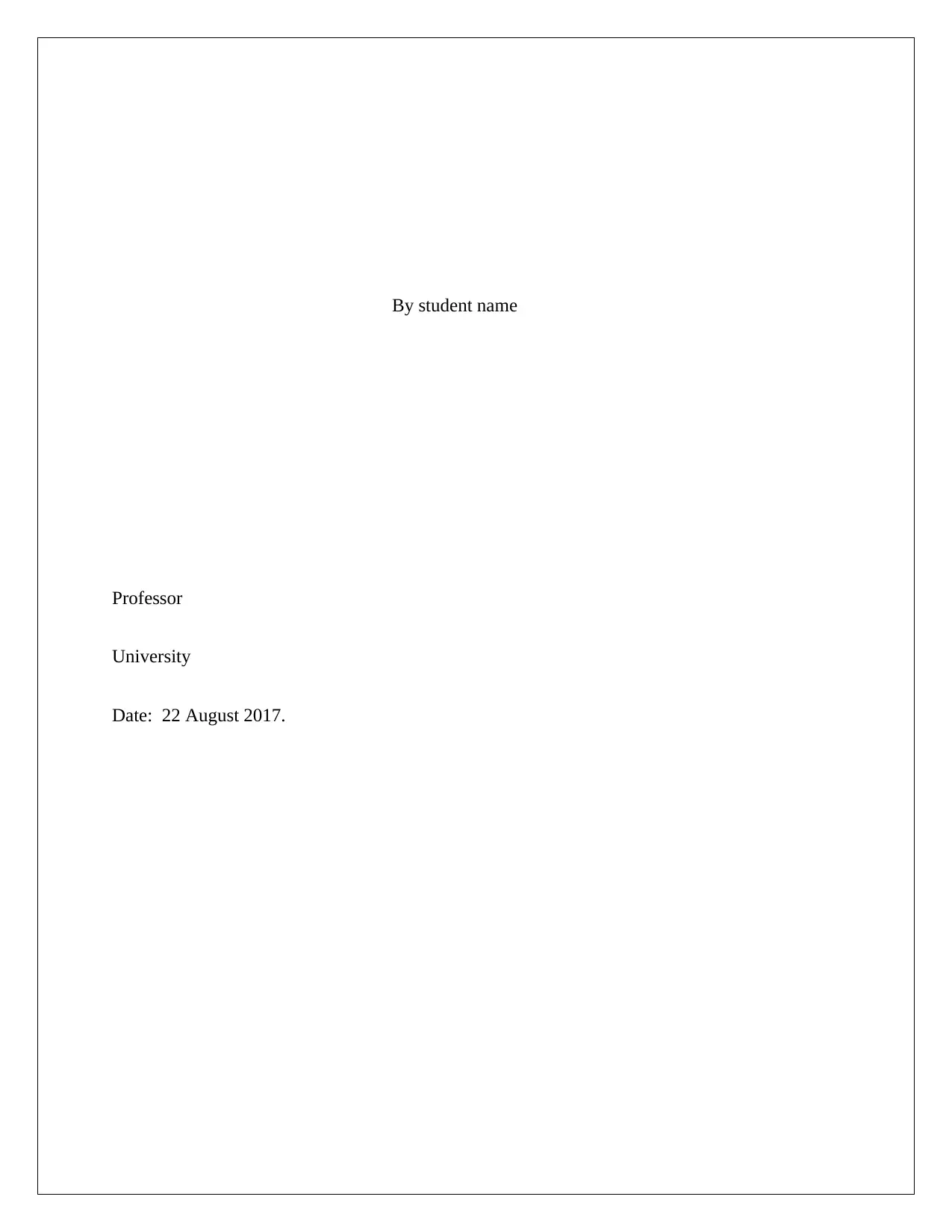
By student name
Professor
University
Date: 22 August 2017.
Professor
University
Date: 22 August 2017.
Paraphrase This Document
Need a fresh take? Get an instant paraphrase of this document with our AI Paraphraser
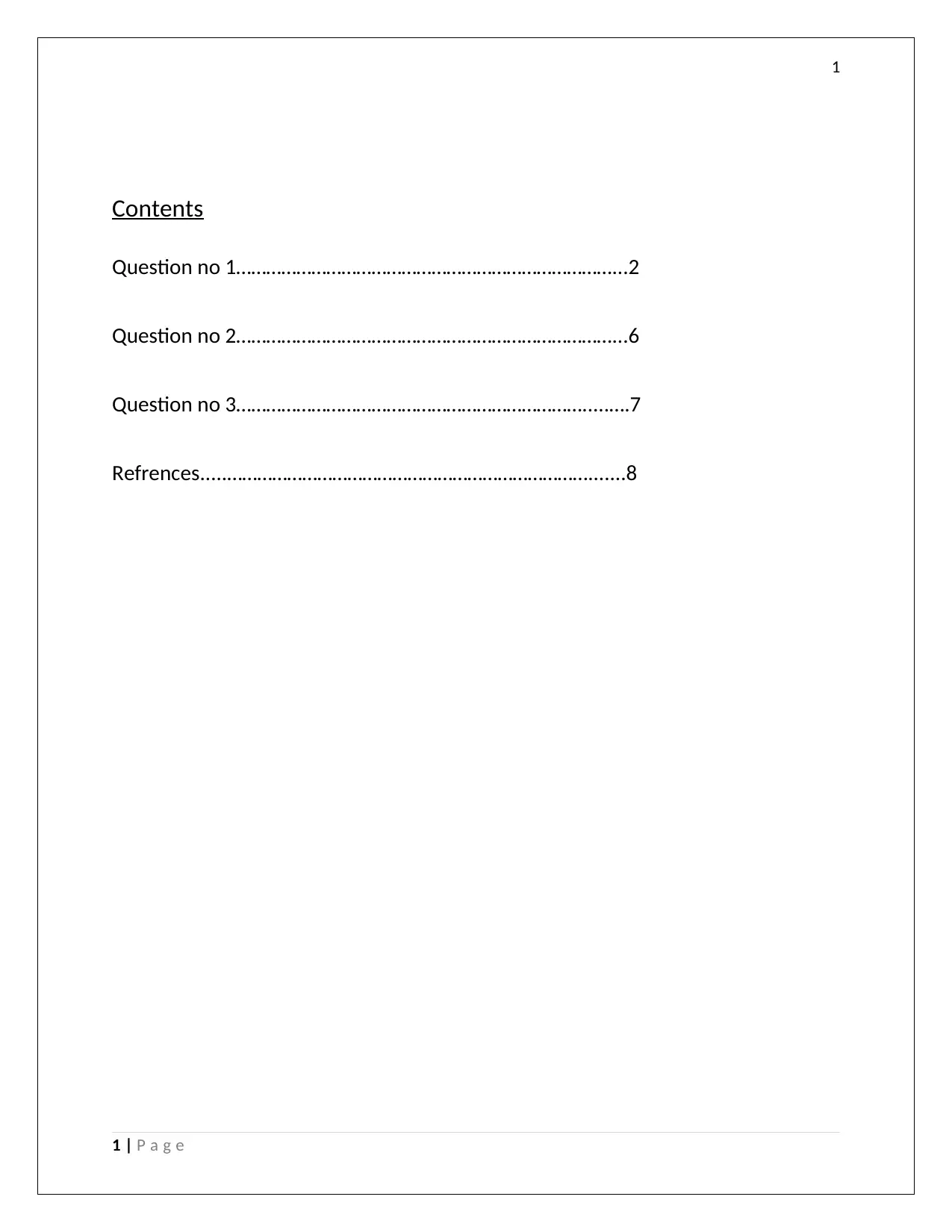
1
Contents
Question no 1…………………………………………………………………...2
Question no 2…………………………………………………………………...6
Question no 3…………………………………………………………….....….7
Refrences.....……………………………………………………………….......8
1 | P a g e
Contents
Question no 1…………………………………………………………………...2
Question no 2…………………………………………………………………...6
Question no 3…………………………………………………………….....….7
Refrences.....……………………………………………………………….......8
1 | P a g e
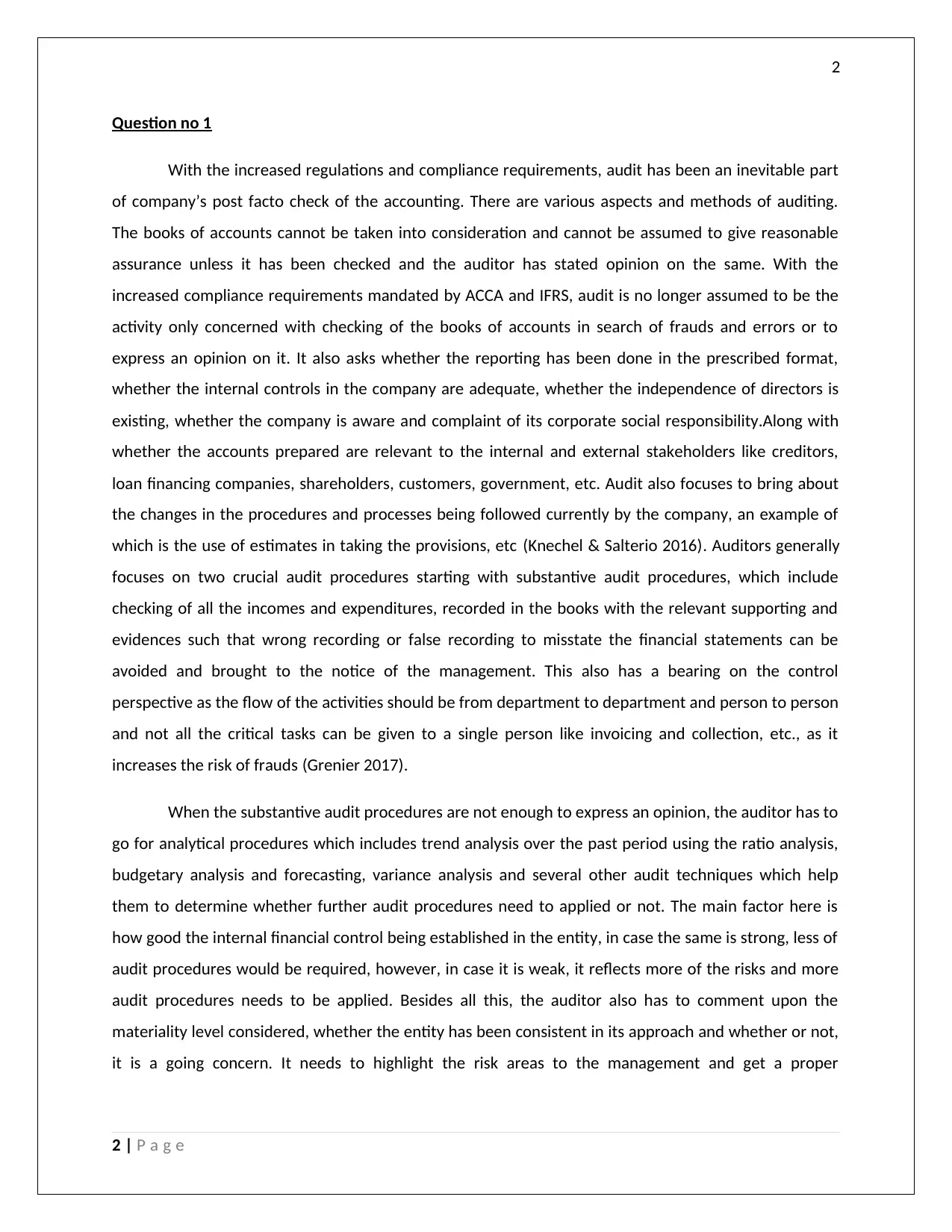
2
Question no 1
With the increased regulations and compliance requirements, audit has been an inevitable part
of company’s post facto check of the accounting. There are various aspects and methods of auditing.
The books of accounts cannot be taken into consideration and cannot be assumed to give reasonable
assurance unless it has been checked and the auditor has stated opinion on the same. With the
increased compliance requirements mandated by ACCA and IFRS, audit is no longer assumed to be the
activity only concerned with checking of the books of accounts in search of frauds and errors or to
express an opinion on it. It also asks whether the reporting has been done in the prescribed format,
whether the internal controls in the company are adequate, whether the independence of directors is
existing, whether the company is aware and complaint of its corporate social responsibility.Along with
whether the accounts prepared are relevant to the internal and external stakeholders like creditors,
loan financing companies, shareholders, customers, government, etc. Audit also focuses to bring about
the changes in the procedures and processes being followed currently by the company, an example of
which is the use of estimates in taking the provisions, etc (Knechel & Salterio 2016). Auditors generally
focuses on two crucial audit procedures starting with substantive audit procedures, which include
checking of all the incomes and expenditures, recorded in the books with the relevant supporting and
evidences such that wrong recording or false recording to misstate the financial statements can be
avoided and brought to the notice of the management. This also has a bearing on the control
perspective as the flow of the activities should be from department to department and person to person
and not all the critical tasks can be given to a single person like invoicing and collection, etc., as it
increases the risk of frauds (Grenier 2017).
When the substantive audit procedures are not enough to express an opinion, the auditor has to
go for analytical procedures which includes trend analysis over the past period using the ratio analysis,
budgetary analysis and forecasting, variance analysis and several other audit techniques which help
them to determine whether further audit procedures need to applied or not. The main factor here is
how good the internal financial control being established in the entity, in case the same is strong, less of
audit procedures would be required, however, in case it is weak, it reflects more of the risks and more
audit procedures needs to be applied. Besides all this, the auditor also has to comment upon the
materiality level considered, whether the entity has been consistent in its approach and whether or not,
it is a going concern. It needs to highlight the risk areas to the management and get a proper
2 | P a g e
Question no 1
With the increased regulations and compliance requirements, audit has been an inevitable part
of company’s post facto check of the accounting. There are various aspects and methods of auditing.
The books of accounts cannot be taken into consideration and cannot be assumed to give reasonable
assurance unless it has been checked and the auditor has stated opinion on the same. With the
increased compliance requirements mandated by ACCA and IFRS, audit is no longer assumed to be the
activity only concerned with checking of the books of accounts in search of frauds and errors or to
express an opinion on it. It also asks whether the reporting has been done in the prescribed format,
whether the internal controls in the company are adequate, whether the independence of directors is
existing, whether the company is aware and complaint of its corporate social responsibility.Along with
whether the accounts prepared are relevant to the internal and external stakeholders like creditors,
loan financing companies, shareholders, customers, government, etc. Audit also focuses to bring about
the changes in the procedures and processes being followed currently by the company, an example of
which is the use of estimates in taking the provisions, etc (Knechel & Salterio 2016). Auditors generally
focuses on two crucial audit procedures starting with substantive audit procedures, which include
checking of all the incomes and expenditures, recorded in the books with the relevant supporting and
evidences such that wrong recording or false recording to misstate the financial statements can be
avoided and brought to the notice of the management. This also has a bearing on the control
perspective as the flow of the activities should be from department to department and person to person
and not all the critical tasks can be given to a single person like invoicing and collection, etc., as it
increases the risk of frauds (Grenier 2017).
When the substantive audit procedures are not enough to express an opinion, the auditor has to
go for analytical procedures which includes trend analysis over the past period using the ratio analysis,
budgetary analysis and forecasting, variance analysis and several other audit techniques which help
them to determine whether further audit procedures need to applied or not. The main factor here is
how good the internal financial control being established in the entity, in case the same is strong, less of
audit procedures would be required, however, in case it is weak, it reflects more of the risks and more
audit procedures needs to be applied. Besides all this, the auditor also has to comment upon the
materiality level considered, whether the entity has been consistent in its approach and whether or not,
it is a going concern. It needs to highlight the risk areas to the management and get a proper
2 | P a g e
⊘ This is a preview!⊘
Do you want full access?
Subscribe today to unlock all pages.

Trusted by 1+ million students worldwide
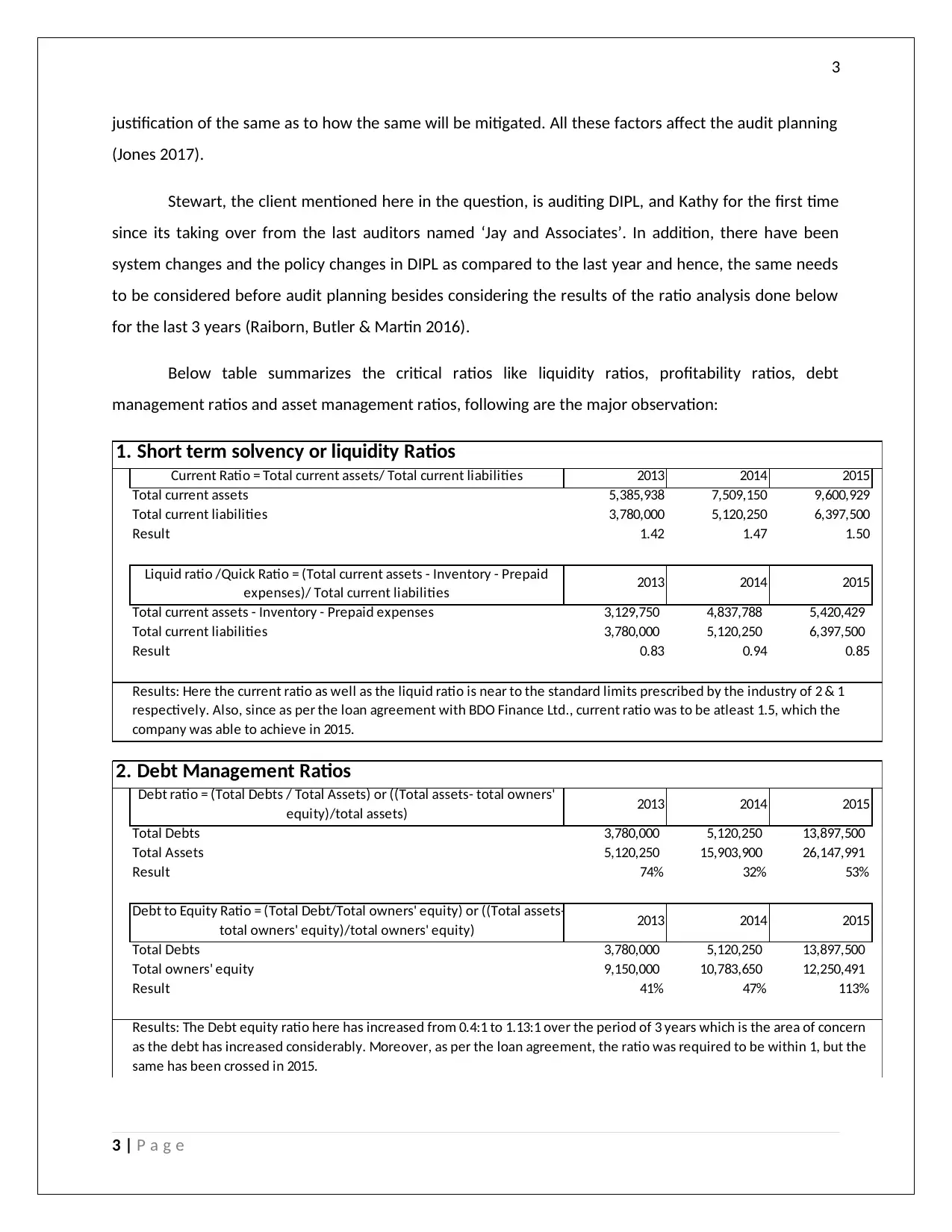
3
justification of the same as to how the same will be mitigated. All these factors affect the audit planning
(Jones 2017).
Stewart, the client mentioned here in the question, is auditing DIPL, and Kathy for the first time
since its taking over from the last auditors named ‘Jay and Associates’. In addition, there have been
system changes and the policy changes in DIPL as compared to the last year and hence, the same needs
to be considered before audit planning besides considering the results of the ratio analysis done below
for the last 3 years (Raiborn, Butler & Martin 2016).
Below table summarizes the critical ratios like liquidity ratios, profitability ratios, debt
management ratios and asset management ratios, following are the major observation:
2013 2014 2015
Total current assets 5,385,938 7,509,150 9,600,929
Total current liabilities 3,780,000 5,120,250 6,397,500
Result 1.42 1.47 1.50
2013 2014 2015
Total current assets - Inventory - Prepaid expenses 3,129,750 4,837,788 5,420,429
Total current liabilities 3,780,000 5,120,250 6,397,500
Result 0.83 0.94 0.85
2013 2014 2015
Total Debts 3,780,000 5,120,250 13,897,500
Total Assets 5,120,250 15,903,900 26,147,991
Result 74% 32% 53%
2013 2014 2015
Total Debts 3,780,000 5,120,250 13,897,500
Total owners' equity 9,150,000 10,783,650 12,250,491
Result 41% 47% 113%
Current Ratio = Total current assets/ Total current liabilities
Liquid ratio /Quick Ratio = (Total current assets - Inventory - Prepaid
expenses)/ Total current liabilities
Debt ratio = (Total Debts / Total Assets) or ((Total assets- total owners'
equity)/total assets)
Debt to Equity Ratio = (Total Debt/Total owners' equity) or ((Total assets-
total owners' equity)/total owners' equity)
Results: Here the current ratio as well as the liquid ratio is near to the standard limits prescribed by the industry of 2 & 1
respectively. Also, since as per the loan agreement with BDO Finance Ltd., current ratio was to be atleast 1.5, which the
company was able to achieve in 2015.
1. Short term solvency or liquidity Ratios
2. Debt Management Ratios
Results: The Debt equity ratio here has increased from 0.4:1 to 1.13:1 over the period of 3 years which is the area of concern
as the debt has increased considerably. Moreover, as per the loan agreement, the ratio was required to be within 1, but the
same has been crossed in 2015.
3 | P a g e
justification of the same as to how the same will be mitigated. All these factors affect the audit planning
(Jones 2017).
Stewart, the client mentioned here in the question, is auditing DIPL, and Kathy for the first time
since its taking over from the last auditors named ‘Jay and Associates’. In addition, there have been
system changes and the policy changes in DIPL as compared to the last year and hence, the same needs
to be considered before audit planning besides considering the results of the ratio analysis done below
for the last 3 years (Raiborn, Butler & Martin 2016).
Below table summarizes the critical ratios like liquidity ratios, profitability ratios, debt
management ratios and asset management ratios, following are the major observation:
2013 2014 2015
Total current assets 5,385,938 7,509,150 9,600,929
Total current liabilities 3,780,000 5,120,250 6,397,500
Result 1.42 1.47 1.50
2013 2014 2015
Total current assets - Inventory - Prepaid expenses 3,129,750 4,837,788 5,420,429
Total current liabilities 3,780,000 5,120,250 6,397,500
Result 0.83 0.94 0.85
2013 2014 2015
Total Debts 3,780,000 5,120,250 13,897,500
Total Assets 5,120,250 15,903,900 26,147,991
Result 74% 32% 53%
2013 2014 2015
Total Debts 3,780,000 5,120,250 13,897,500
Total owners' equity 9,150,000 10,783,650 12,250,491
Result 41% 47% 113%
Current Ratio = Total current assets/ Total current liabilities
Liquid ratio /Quick Ratio = (Total current assets - Inventory - Prepaid
expenses)/ Total current liabilities
Debt ratio = (Total Debts / Total Assets) or ((Total assets- total owners'
equity)/total assets)
Debt to Equity Ratio = (Total Debt/Total owners' equity) or ((Total assets-
total owners' equity)/total owners' equity)
Results: Here the current ratio as well as the liquid ratio is near to the standard limits prescribed by the industry of 2 & 1
respectively. Also, since as per the loan agreement with BDO Finance Ltd., current ratio was to be atleast 1.5, which the
company was able to achieve in 2015.
1. Short term solvency or liquidity Ratios
2. Debt Management Ratios
Results: The Debt equity ratio here has increased from 0.4:1 to 1.13:1 over the period of 3 years which is the area of concern
as the debt has increased considerably. Moreover, as per the loan agreement, the ratio was required to be within 1, but the
same has been crossed in 2015.
3 | P a g e
Paraphrase This Document
Need a fresh take? Get an instant paraphrase of this document with our AI Paraphraser
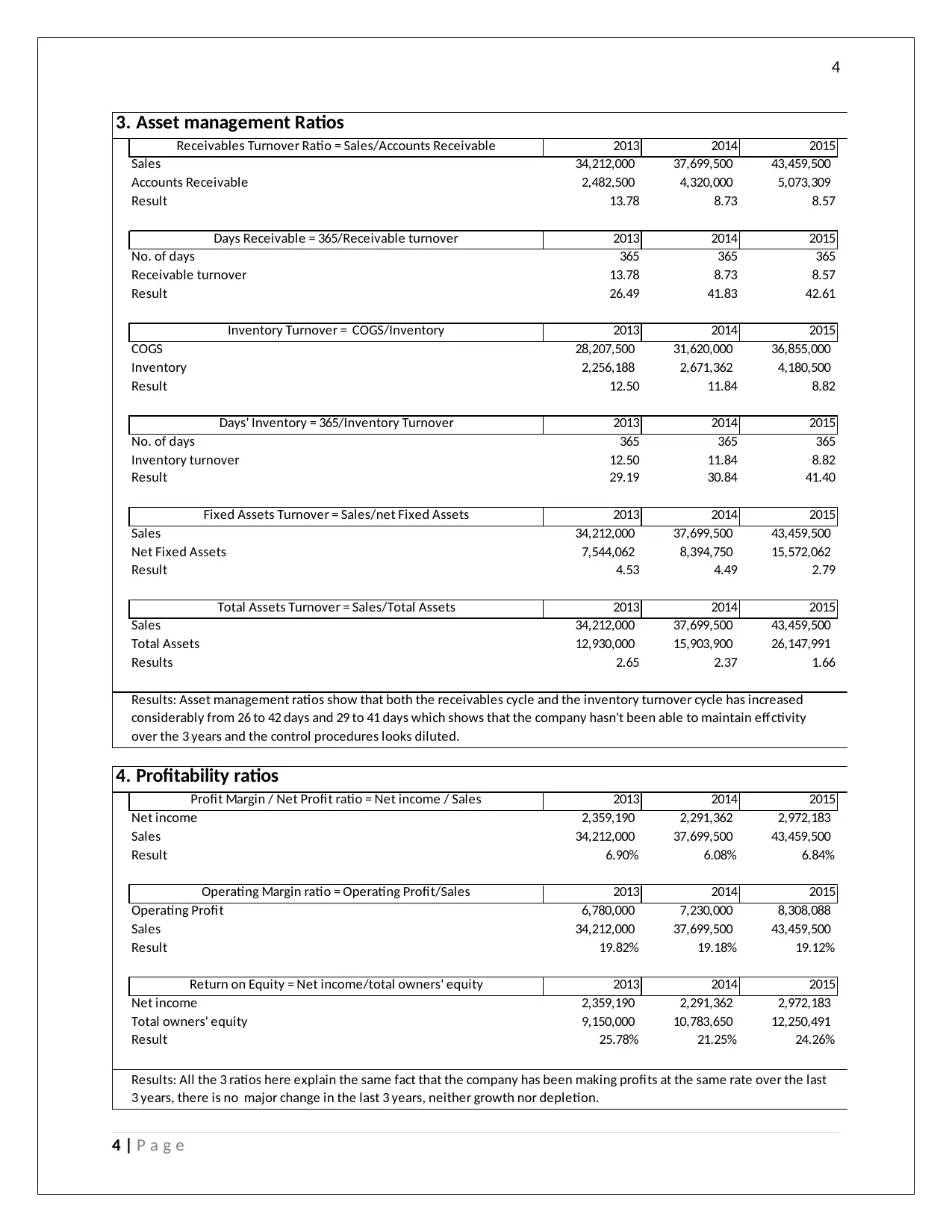
4
2013 2014 2015
Sales 34,212,000 37,699,500 43,459,500
Accounts Receivable 2,482,500 4,320,000 5,073,309
Result 13.78 8.73 8.57
2013 2014 2015
No. of days 365 365 365
Receivable turnover 13.78 8.73 8.57
Result 26.49 41.83 42.61
2013 2014 2015
COGS 28,207,500 31,620,000 36,855,000
Inventory 2,256,188 2,671,362 4,180,500
Result 12.50 11.84 8.82
2013 2014 2015
No. of days 365 365 365
Inventory turnover 12.50 11.84 8.82
Result 29.19 30.84 41.40
2013 2014 2015
Sales 34,212,000 37,699,500 43,459,500
Net Fixed Assets 7,544,062 8,394,750 15,572,062
Result 4.53 4.49 2.79
2013 2014 2015
Sales 34,212,000 37,699,500 43,459,500
Total Assets 12,930,000 15,903,900 26,147,991
Results 2.65 2.37 1.66
2013 2014 2015
Net income 2,359,190 2,291,362 2,972,183
Sales 34,212,000 37,699,500 43,459,500
Result 6.90% 6.08% 6.84%
2013 2014 2015
Operating Profit 6,780,000 7,230,000 8,308,088
Sales 34,212,000 37,699,500 43,459,500
Result 19.82% 19.18% 19.12%
2013 2014 2015
Net income 2,359,190 2,291,362 2,972,183
Total owners' equity 9,150,000 10,783,650 12,250,491
Result 25.78% 21.25% 24.26%
Results: Asset management ratios show that both the receivables cycle and the inventory turnover cycle has increased
considerably from 26 to 42 days and 29 to 41 days which shows that the company hasn't been able to maintain effctivity
over the 3 years and the control procedures looks diluted.
Results: All the 3 ratios here explain the same fact that the company has been making profits at the same rate over the last
3 years, there is no major change in the last 3 years, neither growth nor depletion.
Inventory Turnover = COGS/Inventory
Days' Inventory = 365/Inventory Turnover
Fixed Assets Turnover = Sales/net Fixed Assets
Total Assets Turnover = Sales/Total Assets
Profit Margin / Net Profit ratio = Net income / Sales
Operating Margin ratio = Operating Profit/Sales
Return on Equity = Net income/total owners' equity
Receivables Turnover Ratio = Sales/Accounts Receivable
Days Receivable = 365/Receivable turnover
4. Profitability ratios
3. Asset management Ratios
4 | P a g e
2013 2014 2015
Sales 34,212,000 37,699,500 43,459,500
Accounts Receivable 2,482,500 4,320,000 5,073,309
Result 13.78 8.73 8.57
2013 2014 2015
No. of days 365 365 365
Receivable turnover 13.78 8.73 8.57
Result 26.49 41.83 42.61
2013 2014 2015
COGS 28,207,500 31,620,000 36,855,000
Inventory 2,256,188 2,671,362 4,180,500
Result 12.50 11.84 8.82
2013 2014 2015
No. of days 365 365 365
Inventory turnover 12.50 11.84 8.82
Result 29.19 30.84 41.40
2013 2014 2015
Sales 34,212,000 37,699,500 43,459,500
Net Fixed Assets 7,544,062 8,394,750 15,572,062
Result 4.53 4.49 2.79
2013 2014 2015
Sales 34,212,000 37,699,500 43,459,500
Total Assets 12,930,000 15,903,900 26,147,991
Results 2.65 2.37 1.66
2013 2014 2015
Net income 2,359,190 2,291,362 2,972,183
Sales 34,212,000 37,699,500 43,459,500
Result 6.90% 6.08% 6.84%
2013 2014 2015
Operating Profit 6,780,000 7,230,000 8,308,088
Sales 34,212,000 37,699,500 43,459,500
Result 19.82% 19.18% 19.12%
2013 2014 2015
Net income 2,359,190 2,291,362 2,972,183
Total owners' equity 9,150,000 10,783,650 12,250,491
Result 25.78% 21.25% 24.26%
Results: Asset management ratios show that both the receivables cycle and the inventory turnover cycle has increased
considerably from 26 to 42 days and 29 to 41 days which shows that the company hasn't been able to maintain effctivity
over the 3 years and the control procedures looks diluted.
Results: All the 3 ratios here explain the same fact that the company has been making profits at the same rate over the last
3 years, there is no major change in the last 3 years, neither growth nor depletion.
Inventory Turnover = COGS/Inventory
Days' Inventory = 365/Inventory Turnover
Fixed Assets Turnover = Sales/net Fixed Assets
Total Assets Turnover = Sales/Total Assets
Profit Margin / Net Profit ratio = Net income / Sales
Operating Margin ratio = Operating Profit/Sales
Return on Equity = Net income/total owners' equity
Receivables Turnover Ratio = Sales/Accounts Receivable
Days Receivable = 365/Receivable turnover
4. Profitability ratios
3. Asset management Ratios
4 | P a g e
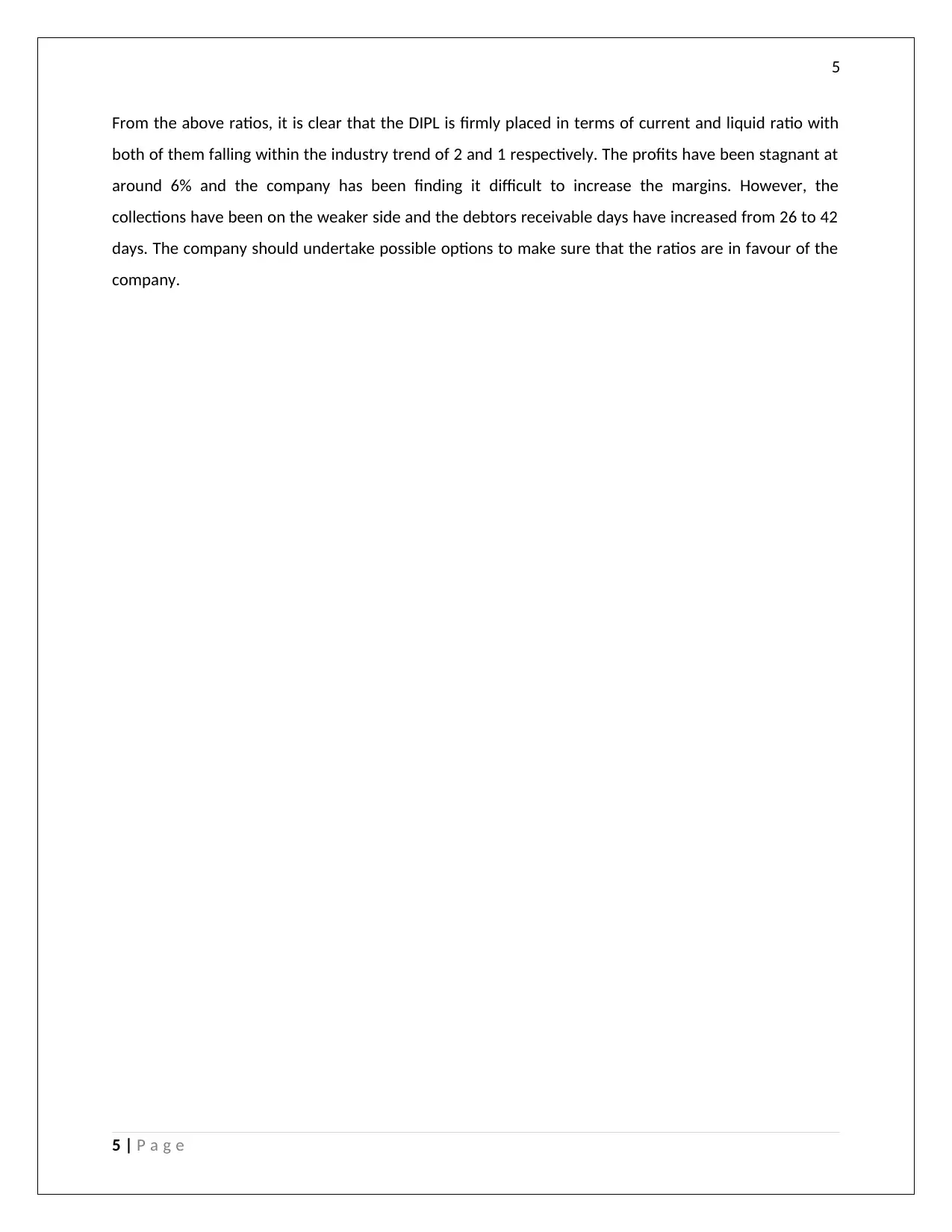
5
From the above ratios, it is clear that the DIPL is firmly placed in terms of current and liquid ratio with
both of them falling within the industry trend of 2 and 1 respectively. The profits have been stagnant at
around 6% and the company has been finding it difficult to increase the margins. However, the
collections have been on the weaker side and the debtors receivable days have increased from 26 to 42
days. The company should undertake possible options to make sure that the ratios are in favour of the
company.
5 | P a g e
From the above ratios, it is clear that the DIPL is firmly placed in terms of current and liquid ratio with
both of them falling within the industry trend of 2 and 1 respectively. The profits have been stagnant at
around 6% and the company has been finding it difficult to increase the margins. However, the
collections have been on the weaker side and the debtors receivable days have increased from 26 to 42
days. The company should undertake possible options to make sure that the ratios are in favour of the
company.
5 | P a g e
⊘ This is a preview!⊘
Do you want full access?
Subscribe today to unlock all pages.

Trusted by 1+ million students worldwide
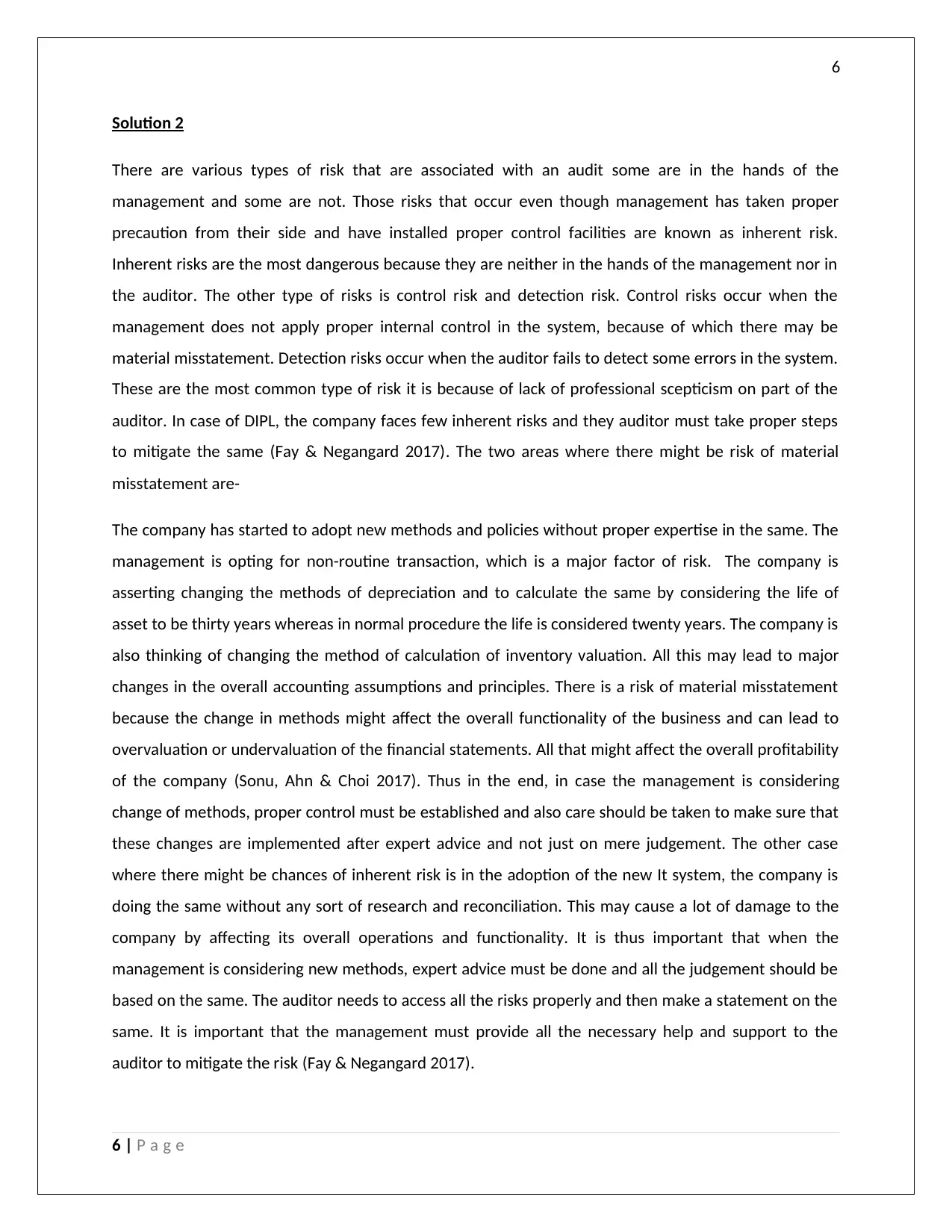
6
Solution 2
There are various types of risk that are associated with an audit some are in the hands of the
management and some are not. Those risks that occur even though management has taken proper
precaution from their side and have installed proper control facilities are known as inherent risk.
Inherent risks are the most dangerous because they are neither in the hands of the management nor in
the auditor. The other type of risks is control risk and detection risk. Control risks occur when the
management does not apply proper internal control in the system, because of which there may be
material misstatement. Detection risks occur when the auditor fails to detect some errors in the system.
These are the most common type of risk it is because of lack of professional scepticism on part of the
auditor. In case of DIPL, the company faces few inherent risks and they auditor must take proper steps
to mitigate the same (Fay & Negangard 2017). The two areas where there might be risk of material
misstatement are-
The company has started to adopt new methods and policies without proper expertise in the same. The
management is opting for non-routine transaction, which is a major factor of risk. The company is
asserting changing the methods of depreciation and to calculate the same by considering the life of
asset to be thirty years whereas in normal procedure the life is considered twenty years. The company is
also thinking of changing the method of calculation of inventory valuation. All this may lead to major
changes in the overall accounting assumptions and principles. There is a risk of material misstatement
because the change in methods might affect the overall functionality of the business and can lead to
overvaluation or undervaluation of the financial statements. All that might affect the overall profitability
of the company (Sonu, Ahn & Choi 2017). Thus in the end, in case the management is considering
change of methods, proper control must be established and also care should be taken to make sure that
these changes are implemented after expert advice and not just on mere judgement. The other case
where there might be chances of inherent risk is in the adoption of the new It system, the company is
doing the same without any sort of research and reconciliation. This may cause a lot of damage to the
company by affecting its overall operations and functionality. It is thus important that when the
management is considering new methods, expert advice must be done and all the judgement should be
based on the same. The auditor needs to access all the risks properly and then make a statement on the
same. It is important that the management must provide all the necessary help and support to the
auditor to mitigate the risk (Fay & Negangard 2017).
6 | P a g e
Solution 2
There are various types of risk that are associated with an audit some are in the hands of the
management and some are not. Those risks that occur even though management has taken proper
precaution from their side and have installed proper control facilities are known as inherent risk.
Inherent risks are the most dangerous because they are neither in the hands of the management nor in
the auditor. The other type of risks is control risk and detection risk. Control risks occur when the
management does not apply proper internal control in the system, because of which there may be
material misstatement. Detection risks occur when the auditor fails to detect some errors in the system.
These are the most common type of risk it is because of lack of professional scepticism on part of the
auditor. In case of DIPL, the company faces few inherent risks and they auditor must take proper steps
to mitigate the same (Fay & Negangard 2017). The two areas where there might be risk of material
misstatement are-
The company has started to adopt new methods and policies without proper expertise in the same. The
management is opting for non-routine transaction, which is a major factor of risk. The company is
asserting changing the methods of depreciation and to calculate the same by considering the life of
asset to be thirty years whereas in normal procedure the life is considered twenty years. The company is
also thinking of changing the method of calculation of inventory valuation. All this may lead to major
changes in the overall accounting assumptions and principles. There is a risk of material misstatement
because the change in methods might affect the overall functionality of the business and can lead to
overvaluation or undervaluation of the financial statements. All that might affect the overall profitability
of the company (Sonu, Ahn & Choi 2017). Thus in the end, in case the management is considering
change of methods, proper control must be established and also care should be taken to make sure that
these changes are implemented after expert advice and not just on mere judgement. The other case
where there might be chances of inherent risk is in the adoption of the new It system, the company is
doing the same without any sort of research and reconciliation. This may cause a lot of damage to the
company by affecting its overall operations and functionality. It is thus important that when the
management is considering new methods, expert advice must be done and all the judgement should be
based on the same. The auditor needs to access all the risks properly and then make a statement on the
same. It is important that the management must provide all the necessary help and support to the
auditor to mitigate the risk (Fay & Negangard 2017).
6 | P a g e
Paraphrase This Document
Need a fresh take? Get an instant paraphrase of this document with our AI Paraphraser
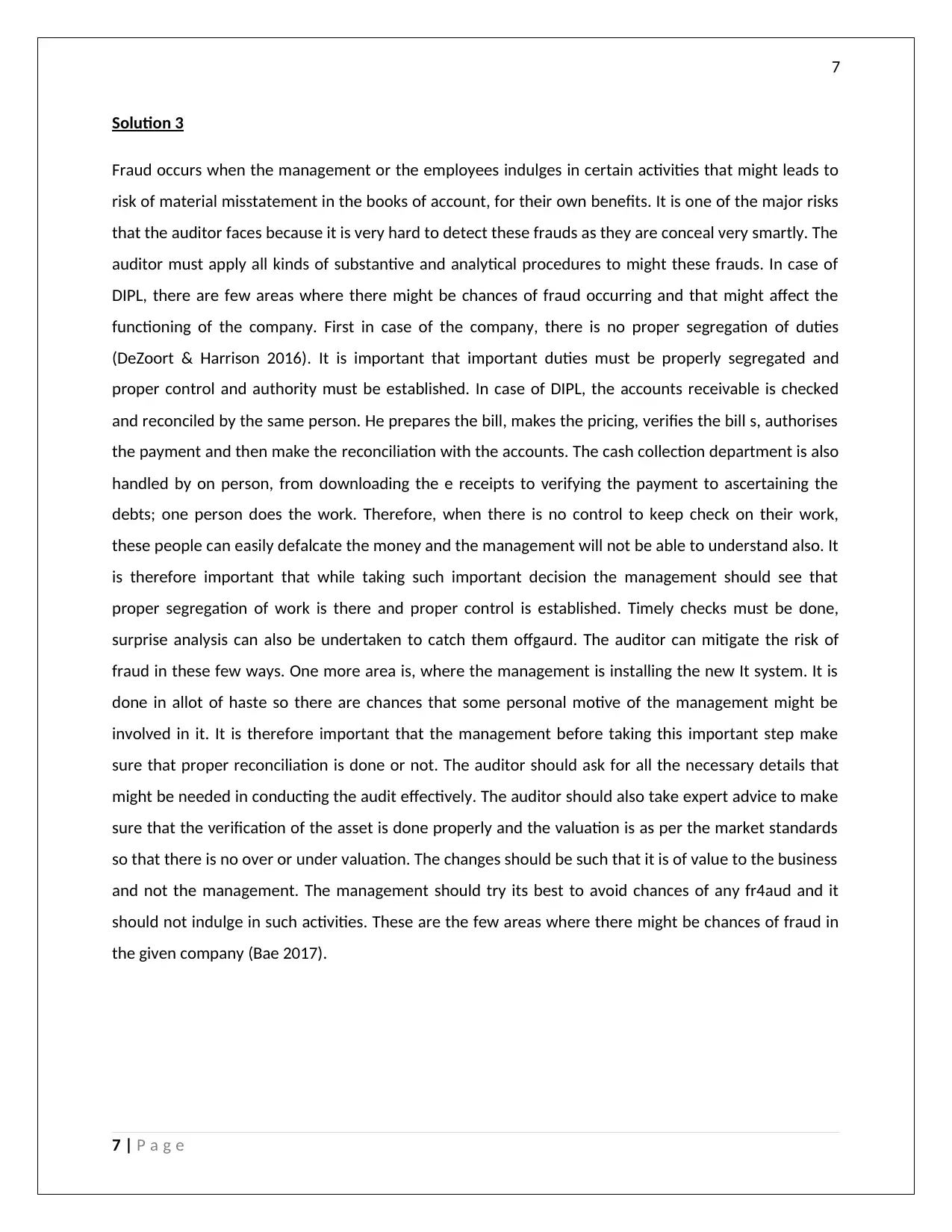
7
Solution 3
Fraud occurs when the management or the employees indulges in certain activities that might leads to
risk of material misstatement in the books of account, for their own benefits. It is one of the major risks
that the auditor faces because it is very hard to detect these frauds as they are conceal very smartly. The
auditor must apply all kinds of substantive and analytical procedures to might these frauds. In case of
DIPL, there are few areas where there might be chances of fraud occurring and that might affect the
functioning of the company. First in case of the company, there is no proper segregation of duties
(DeZoort & Harrison 2016). It is important that important duties must be properly segregated and
proper control and authority must be established. In case of DIPL, the accounts receivable is checked
and reconciled by the same person. He prepares the bill, makes the pricing, verifies the bill s, authorises
the payment and then make the reconciliation with the accounts. The cash collection department is also
handled by on person, from downloading the e receipts to verifying the payment to ascertaining the
debts; one person does the work. Therefore, when there is no control to keep check on their work,
these people can easily defalcate the money and the management will not be able to understand also. It
is therefore important that while taking such important decision the management should see that
proper segregation of work is there and proper control is established. Timely checks must be done,
surprise analysis can also be undertaken to catch them offgaurd. The auditor can mitigate the risk of
fraud in these few ways. One more area is, where the management is installing the new It system. It is
done in allot of haste so there are chances that some personal motive of the management might be
involved in it. It is therefore important that the management before taking this important step make
sure that proper reconciliation is done or not. The auditor should ask for all the necessary details that
might be needed in conducting the audit effectively. The auditor should also take expert advice to make
sure that the verification of the asset is done properly and the valuation is as per the market standards
so that there is no over or under valuation. The changes should be such that it is of value to the business
and not the management. The management should try its best to avoid chances of any fr4aud and it
should not indulge in such activities. These are the few areas where there might be chances of fraud in
the given company (Bae 2017).
7 | P a g e
Solution 3
Fraud occurs when the management or the employees indulges in certain activities that might leads to
risk of material misstatement in the books of account, for their own benefits. It is one of the major risks
that the auditor faces because it is very hard to detect these frauds as they are conceal very smartly. The
auditor must apply all kinds of substantive and analytical procedures to might these frauds. In case of
DIPL, there are few areas where there might be chances of fraud occurring and that might affect the
functioning of the company. First in case of the company, there is no proper segregation of duties
(DeZoort & Harrison 2016). It is important that important duties must be properly segregated and
proper control and authority must be established. In case of DIPL, the accounts receivable is checked
and reconciled by the same person. He prepares the bill, makes the pricing, verifies the bill s, authorises
the payment and then make the reconciliation with the accounts. The cash collection department is also
handled by on person, from downloading the e receipts to verifying the payment to ascertaining the
debts; one person does the work. Therefore, when there is no control to keep check on their work,
these people can easily defalcate the money and the management will not be able to understand also. It
is therefore important that while taking such important decision the management should see that
proper segregation of work is there and proper control is established. Timely checks must be done,
surprise analysis can also be undertaken to catch them offgaurd. The auditor can mitigate the risk of
fraud in these few ways. One more area is, where the management is installing the new It system. It is
done in allot of haste so there are chances that some personal motive of the management might be
involved in it. It is therefore important that the management before taking this important step make
sure that proper reconciliation is done or not. The auditor should ask for all the necessary details that
might be needed in conducting the audit effectively. The auditor should also take expert advice to make
sure that the verification of the asset is done properly and the valuation is as per the market standards
so that there is no over or under valuation. The changes should be such that it is of value to the business
and not the management. The management should try its best to avoid chances of any fr4aud and it
should not indulge in such activities. These are the few areas where there might be chances of fraud in
the given company (Bae 2017).
7 | P a g e
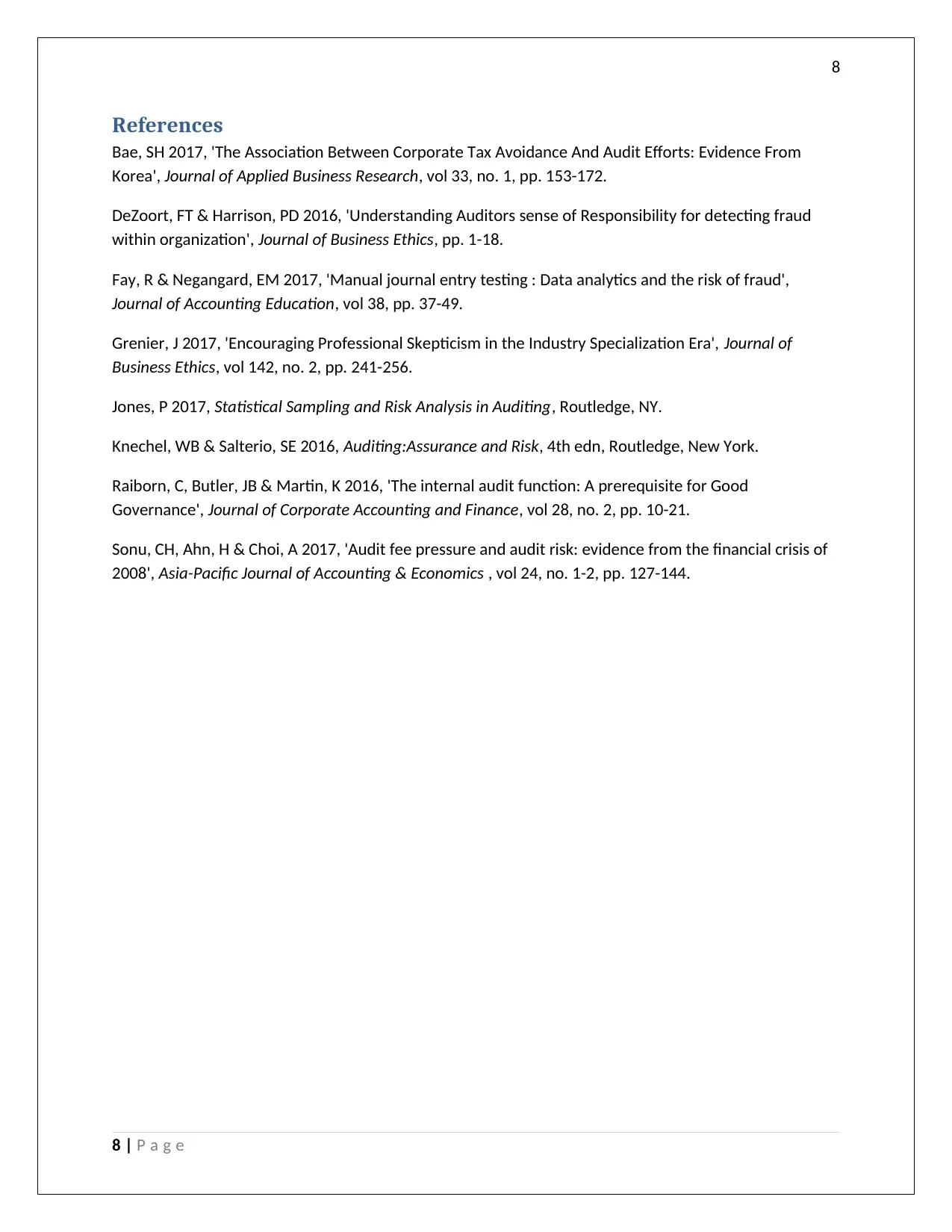
8
References
Bae, SH 2017, 'The Association Between Corporate Tax Avoidance And Audit Efforts: Evidence From
Korea', Journal of Applied Business Research, vol 33, no. 1, pp. 153-172.
DeZoort, FT & Harrison, PD 2016, 'Understanding Auditors sense of Responsibility for detecting fraud
within organization', Journal of Business Ethics, pp. 1-18.
Fay, R & Negangard, EM 2017, 'Manual journal entry testing : Data analytics and the risk of fraud',
Journal of Accounting Education, vol 38, pp. 37-49.
Grenier, J 2017, 'Encouraging Professional Skepticism in the Industry Specialization Era', Journal of
Business Ethics, vol 142, no. 2, pp. 241-256.
Jones, P 2017, Statistical Sampling and Risk Analysis in Auditing, Routledge, NY.
Knechel, WB & Salterio, SE 2016, Auditing:Assurance and Risk, 4th edn, Routledge, New York.
Raiborn, C, Butler, JB & Martin, K 2016, 'The internal audit function: A prerequisite for Good
Governance', Journal of Corporate Accounting and Finance, vol 28, no. 2, pp. 10-21.
Sonu, CH, Ahn, H & Choi, A 2017, 'Audit fee pressure and audit risk: evidence from the financial crisis of
2008', Asia-Pacific Journal of Accounting & Economics , vol 24, no. 1-2, pp. 127-144.
8 | P a g e
References
Bae, SH 2017, 'The Association Between Corporate Tax Avoidance And Audit Efforts: Evidence From
Korea', Journal of Applied Business Research, vol 33, no. 1, pp. 153-172.
DeZoort, FT & Harrison, PD 2016, 'Understanding Auditors sense of Responsibility for detecting fraud
within organization', Journal of Business Ethics, pp. 1-18.
Fay, R & Negangard, EM 2017, 'Manual journal entry testing : Data analytics and the risk of fraud',
Journal of Accounting Education, vol 38, pp. 37-49.
Grenier, J 2017, 'Encouraging Professional Skepticism in the Industry Specialization Era', Journal of
Business Ethics, vol 142, no. 2, pp. 241-256.
Jones, P 2017, Statistical Sampling and Risk Analysis in Auditing, Routledge, NY.
Knechel, WB & Salterio, SE 2016, Auditing:Assurance and Risk, 4th edn, Routledge, New York.
Raiborn, C, Butler, JB & Martin, K 2016, 'The internal audit function: A prerequisite for Good
Governance', Journal of Corporate Accounting and Finance, vol 28, no. 2, pp. 10-21.
Sonu, CH, Ahn, H & Choi, A 2017, 'Audit fee pressure and audit risk: evidence from the financial crisis of
2008', Asia-Pacific Journal of Accounting & Economics , vol 24, no. 1-2, pp. 127-144.
8 | P a g e
⊘ This is a preview!⊘
Do you want full access?
Subscribe today to unlock all pages.

Trusted by 1+ million students worldwide
1 out of 9
Related Documents
Your All-in-One AI-Powered Toolkit for Academic Success.
+13062052269
info@desklib.com
Available 24*7 on WhatsApp / Email
![[object Object]](/_next/static/media/star-bottom.7253800d.svg)
Unlock your academic potential
Copyright © 2020–2025 A2Z Services. All Rights Reserved. Developed and managed by ZUCOL.





